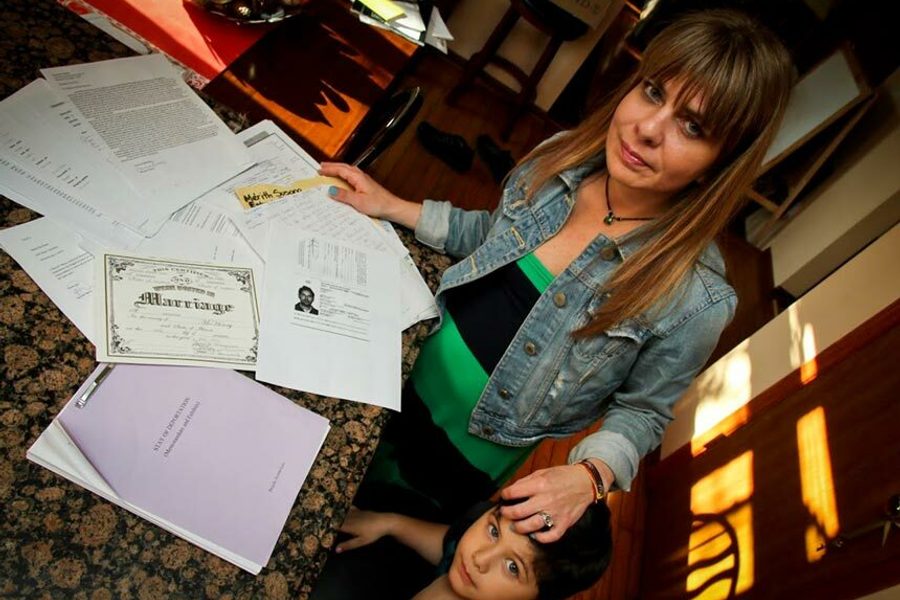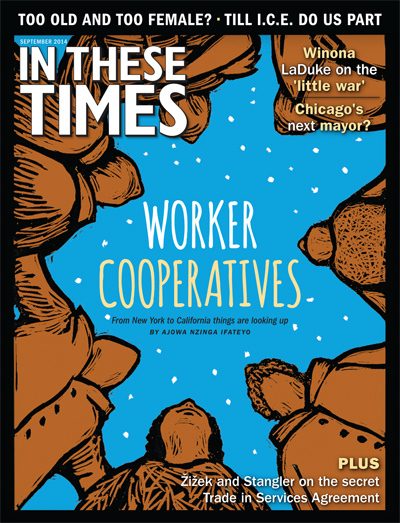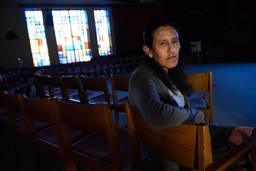Till I.C.E. Do Us Part
Tens of thousands of American families are torn asunder by U.S. immigration policies.
Yana Kunichoff

On November 17, 2013, Brígido Acosta Luís was walked across the U.S.-Mexico border by immigration authorities from Brownsville, Texas, to the northern Mexican city of Matamoros. He was dressed in the pajamas he had been wearing the evening that Immigration and Customs Enforcement (ICE) agents arrested him at his home in the Chicago suburb of Schaumburg, Illlinois, four weeks earlier.
Deportation was an abrupt end to the life 33-year-old Acosta had built in the six years since he illegally crossed the border to the United States in 2007. In Schaumburg, he had a wife, Maria Paz Perez, a 3-year-old son, Xavier, and a teenage stepdaughter, Isabel, all of them American citizens. He had also started a small insurance business with Perez. After Acosta’s deportation, the daily lives of Perez and her two children swiftly began to unravel.
First to change was the family’s daily routine. Perez, who works full-time as a case worker for the state of Illinois, scrambled to find someone to pick up her son from school and drive her daughter to cheerleading.
Next to go was the family’s three bedroom apartment. Unable to pay rent while also supporting Acosta, paying lawyers and buying plane tickets for the family to Mexico, Perez and her children moved in with her parents.
Last to go was the insurance business. Lacking the time to manage it alone, Perez shuttered its doors in July.
As the family approaches the one year anniversary of Acosta’s deportation, Perez worries they have lost any chance of a middle-class life. “It’s become a burden on the whole family, including my elderly parents,” she says.
Hear Perez tell her story in this video from immigration-reform advocacy group America’s Voice:
200,000 deported parents
Some 2 million people have been deported under the Obama administration. ICE does not publish data on whether deportees have children in the United States, but government records obtained through a Freedom of Information Act request by the Applied Research Center (now Race Forward), a racial justice think tank, show that about 23 percent of those deported between July 1, 2010, and September 31, 2012 — some 200,000 people — said they had children who were American citizens. Nationally, 4.5 million children who are U.S. citizens have one or more parents who are undocumented and therefore vulnerable to deportation.
Deportation of a parent has been linked to greater housing insecurity, food insecurity, lower grades, emotional distress and, in some cases, children ending up in the foster care system. The effects are social and psychological, but above all economic. Unlike when someone is laid off or hurt on the job, deportation comes with no buffer of unemployment payments or worker’s compensation. The family income plummets overnight. Acosta’s deportation has cut the Perez family’s earnings in half.
Then there are the emotional effects. César Cuauhtémoc García Hernández, a law professor at Capital University and blogger at Crimmigration.com, notes, “When a member of the family has been torn away, that causes a huge emotional impact on everyone, which not surprisingly affects their own ability to continue working.” For Perez, this was certainly true. She used her vacation and sick days to deal with the effects of the deportation, and she says that being a single mother has strained every part of her life, including her job.
Families for Freedom, a New York-based activist group fighting deportations, offers a handbook to help families navigate the monetary difficulties of a deportation or a prolonged immigration detention (an individual fighting removal can remain in custody for over a year).
The questions in the handbook depict a life dismantled. For the deportee: Who will manage your bank account? How will you pay your bills? Protect your credit? Support yourself during the transition back to your country? Do you have enough prescription medication? For the deportee’s family: Who will pick up the children after school or watch them while the remaining parent is at work? What about making rent payments? Did you lose your healthcare when a family member was deported? Have you considered counseling, and if so, how you could pay for it?
Having the time to plan for a deportation or detention can help soften the blow. But increasingly, deportations are “fast-tracked,” leaving deportees little time to prepare.
In ICE’s Chicago area of responsibility, which includes Illinois, Indiana, Kansas, Kentucky, Missouri and Wisconsin, 57 percent of those deported between 2008 and 2011 — more than 25,000 immigrants— received “fast-track” deportations, according to an analysis by the Chicago Reporter. Nationally, the Transactional Records Access Clearinghouse (TRAC), a data-collection project run out of Syracuse University, estimates that 1 in 3 deported immigrants never make it to court, but rather are packed off through an “expedited removal.”
While deportation times vary, “expedited removals” are the fastest possible deportation process. This can range from a week to several months, some or all of which can be spent behind bars.
In Brígido Acosta’s case, only 33 days elapsed from the evening immigration officials came to his door to the afternoon he was flown out of the country. A prior deportation order made him ineligible for a hearing in immigration court, and he was sent straight to deportation proceedings.
According to immigration authorities, Acosta was deported because he reentered the country after being deported previously. But Acosta tells the story differently.
Acosta says that in 2001, while visiting relatives in Schaumburg on a valid tourist visa, he was charged with misdemeanor shoplifting. He wasn’t the one stealing, he says, but was with one of his cousins when she attempted to shoplift clothing. Acosta tells In These Times in a phone call from Guadalajara that he was bailed out the next day and returned to Mexico the week after, believing that was the end of his troubles with U.S. law enforcement.
“In Mexico, once they release you, you are done,” he says. But Acosta still had a pending court date for the next month, which he didn’t attend, and a warrant was issued for his arrest. When he tried to reenter the country in 2002 on another tourist visa, he was stopped on suspicion of migrating to the United States for work. Immigration officers gave him the choice of waiting in federal prison for six months for attempting to immigrate, or going home. He took the next flight back, not realizing that by making this choice, his record now stated that he had been deported from the United States.
Unable to get another visa, Acosta crossed the border illegally into the United States in 2007 and, a year later, began building a life with Perez in Schaumburg.
In February 2013, Acosta was in an argument at the car dealership where he worked, and the police were called. Though he wasn’t charged with anything, the misdemeanor theft charge reared its head when the officers scanned his ID. Acosta retained a lawyer, who counseled him to plead guilty.
Acosta has come to regret that plea. Only months later, ICE agents arrested him, saying that his removal order from his previous 2002 deportation had just been reinstated. Because Acosta was deported under a “reinstatement of removal,” he is barred from entering the country for 10 years.
Reuniting families
Family reunification has long been the guiding principle of the U.S. immigration system: It currently accounts for two-thirds of permanent immigration to the United States. Though the process can still take years, it is this metaphorical “line” immigration opponents are referring to when they tell immigrants to “get in line.”
But the damage deportation does to families has been curiously absent from immigration policy discussions. For example, the U.S. Senate Judiciary Committee held a hearing on March 18, 2013, called “How Comprehensive Immigration Reform Should Address the Needs of Women and Families.” The hearing focused on visa categories that help women immigrate and the healthcare needs of immigrant women. Deportation was only glancingly referenced, despite the disproportionate number of women left to parent alone after their male partner is deported.
Meanwhile, as the government’s enforcement styles have changed over the past seven years, the safeguards in place for families affected by deportation have proven woefully lacking.
In 2007, the Department of Homeland Security began to shift focus from worksite raids to partnerships between ICE and local law enforcement, such as 287(g) and the Secure Communities program, launched in 2008. While the worksite raids included guidelines for identifying and releasing primary caregivers and pregnant or nursing women, the new modes of enforcement have no such protections. The shift has been correlated with a rise in parents placed into deportation proceedings.
Secure Communities also greatly expanded the number of people ICE could screen for immigration violations. As a consequence, immigration authorities have been increasingly criticized for deporting people with minor or no criminal convictions. In fiscal year 2008, more than half of deported immigrants had not been convicted of a crime, according to TRAC.
In response to mounting outrage, the Obama administration released guidelines in 2011 determining whom ICE officers would target for deportation. The policy, known as prosecutorial discretion, stipulated categories of individuals who were priorities for removal— such as immigrants with felony criminal records and immigrants who have reentered the country after a deportation— and gave individual agents latitude in deciding whether to initiate deportation proceedings.
However, an analysis by TRAC found that only 7 percent of cases have been closed using prosecutorial discretion since the order.
“There is a huge discrepancy between the rhetoric and the reality of the Obama administration,” says law professor García Hernández. “The administration has said it’s going after only those individuals who pose a danger to the United States, but in reality, it has cast a very wide net that is capturing individuals who no one would reasonably claim are a threat to our communities.”
The immigration reform bill passed by the Senate in June 2013 has been held up by some as the best hope for a comprehensive solution to stopping the trauma of deportations. Wendy Cervantes, vice president of immigration and child rights policy at First Focus, says that by providing a “road to citizenship,” comprehensive immigration reform would provide undocumented parents with protection from deportation. If the bill had been law when Acosta was picked up last November, he would probably still be in the country; his family ties and strong connection to his community would have put him on the bill’s 13-year pathway to citizenship.
Other immigrant rights groups, like the Chicago-based Moratorium on Deportations and the National Day Laborers Organizing Network, have criticized the bill for ramping up border control and expanding the groups targeted for deportation to include people with offenses like drunk driving. If Acosta, for instance, had had two more misdemeanors on his record, he would not have been eligible for citizenship under the bill.
With the bill seemingly dead in the House, another demand has come to center stage: a moratorium on deportations. Grassroots immigrant groups have long made this their central demand, but in recent months a new layer of fed-up advocates has joined the call. These include large, national non-profit organizations such as the National Council of La Raza, which lobbied heavily for the passage of an immigration bill.
Advocates are now pushing for an executive order by President Obama, who promised in late June to “do as much as I can, on my own, without Congress” on immigration. The extent of Obama’s power — or his will — to provide deportation relief are unclear, but one option would be to give immigrants already in the country the same path to citizenship that the Senate bill would have. That might come too late for Acosta, since the bill’s relief doesn’t apply to those already deported. If the president wanted to go further, he could issue a family reunification order, which would allow deported parents without serious criminal records, like Acosta, to return.
As the days tick by, advocates are growing impatient. “Every day that Obama delays, there are 1,000 people like Acosta deported,” says Lynn Tramonte, deputy director at America’s Voice.
For their part, Acosta and Perez have put major decisions on hold while Acosta fights for reconsideration of his case through immigration appeals courts. If the appeal fails, they will have to decide whether the whole family will move to Mexico or live apart until Acosta is able to apply for entry to the United States in 10 years. It is hard to imagine staying in Schaumburg, but Perez thinks that her family would have few economic and educational opportunities in Mexico.
The decision haunts Perez and Acosta. Last December, while the family was visiting Guadalajara, a man robbed a jewelry store at gunpoint in the local mall they were visiting, a reminder of Mexico’s escalating violence.
Meanwhile, in Schaumburg, Perez says she continues to feel the effects of a broken family. “My son talks to his father on Skype every day, and when he hangs up, he cries,” she says. “We need him back.”

I hope you found this article important. Before you leave, I want to ask you to consider supporting our work with a donation. In These Times needs readers like you to help sustain our mission. We don’t depend on—or want—corporate advertising or deep-pocketed billionaires to fund our journalism. We’re supported by you, the reader, so we can focus on covering the issues that matter most to the progressive movement without fear or compromise.
Our work isn’t hidden behind a paywall because of people like you who support our journalism. We want to keep it that way. If you value the work we do and the movements we cover, please consider donating to In These Times.







